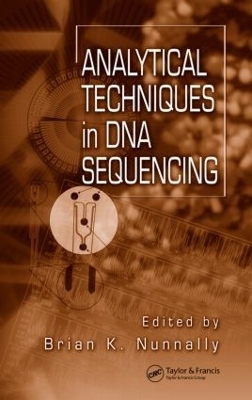
Analytical Techniques In DNA Sequencing
Seiten
2005
Crc Press Inc (Verlag)
978-0-8247-5342-9 (ISBN)
Crc Press Inc (Verlag)
978-0-8247-5342-9 (ISBN)
Offers a look at the DNA sequencing techniques that were developed and put to use during the Human Genome Project. This work traces the development of this branch of research since the early days of radioisotope sequencing. It describes the improvements in DNA separation based on advanced capillary electrophoresis and microchip sequencing.
While one marvels at the DNA generated by the Human Genome Project, perhaps just as significant and fascinating is the development of the amazing analytical technology that has permitted us entry into the genomic era and a whole new level of scientific understanding.
Analytical Techniques in DNA Sequencing takes a look at the various DNA sequencing techniques that were developed and put to use during and after the Human Genome Project. Nunnally makes a special effort to trace the development of this branch of research since the early days of radioisotope sequencing. Special attention is paid to the breakthrough Sanger Method (1977), as well as to several other techniques that improved the accuracy, improved the detection limits, and in a variety of ways dramatically reduced the time needed to generate a DNA sequence.
This comprehensive volume describes the improvements in DNA separation based on advanced capillary electrophoresis and microchip sequencing. It also looks at the use of mass spectrometry and single molecule detection, and takes an in-depth look at the use of various fluorescence methods for the detection of sequencing fragments. One chapter is dedicated to chip-based microfabricated sequencing systems, which could well be the future of DNA sequencing.
The book’s ten chapters, authored by a variety of leading experts in the field, include many of the far-reaching applications of DNA sequencing. Entire chapters are dedicated to DNA typing for forensics, a reevaluation of ancient DNA, and genome analysis.
While one marvels at the DNA generated by the Human Genome Project, perhaps just as significant and fascinating is the development of the amazing analytical technology that has permitted us entry into the genomic era and a whole new level of scientific understanding.
Analytical Techniques in DNA Sequencing takes a look at the various DNA sequencing techniques that were developed and put to use during and after the Human Genome Project. Nunnally makes a special effort to trace the development of this branch of research since the early days of radioisotope sequencing. Special attention is paid to the breakthrough Sanger Method (1977), as well as to several other techniques that improved the accuracy, improved the detection limits, and in a variety of ways dramatically reduced the time needed to generate a DNA sequence.
This comprehensive volume describes the improvements in DNA separation based on advanced capillary electrophoresis and microchip sequencing. It also looks at the use of mass spectrometry and single molecule detection, and takes an in-depth look at the use of various fluorescence methods for the detection of sequencing fragments. One chapter is dedicated to chip-based microfabricated sequencing systems, which could well be the future of DNA sequencing.
The book’s ten chapters, authored by a variety of leading experts in the field, include many of the far-reaching applications of DNA sequencing. Entire chapters are dedicated to DNA typing for forensics, a reevaluation of ancient DNA, and genome analysis.
Brian K. Nunnally
Introduction to DNA Sequencing: Sanger and Beyond. Developments in the Detection of DNA Sequencing Fragments Using Fluorescence: Energy Transfer and Fluorescence Lifetimes. Microscale Sample Preparation for DNA Sequencing and Genotyping. Microfabricated DNA Sequencing Devices. Analysis of Nucleic Acids by Mass Spectrometry. Sequencing the Single DNA Molecule. DNA Sequencing for Genome Analysis. Sequence Reconstruction from Nucleic-Acid Micro-Array Data. Ancient DNA. Forensic DNA Sequencing.
| Erscheint lt. Verlag | 23.6.2005 |
|---|---|
| Zusatzinfo | 6 Tables, black and white; 1 Halftones, black and white; 2 Illustrations, color; 82 Illustrations, black and white |
| Verlagsort | Bosa Roca |
| Sprache | englisch |
| Maße | 156 x 234 mm |
| Gewicht | 498 g |
| Themenwelt | Studium ► 1. Studienabschnitt (Vorklinik) ► Histologie / Embryologie |
| Naturwissenschaften ► Biologie ► Biochemie | |
| Naturwissenschaften ► Biologie ► Genetik / Molekularbiologie | |
| ISBN-10 | 0-8247-5342-9 / 0824753429 |
| ISBN-13 | 978-0-8247-5342-9 / 9780824753429 |
| Zustand | Neuware |
| Haben Sie eine Frage zum Produkt? |
Mehr entdecken
aus dem Bereich
aus dem Bereich
Zytologie, Histologie und mikroskopische Anatomie
Buch | Hardcover (2022)
Urban & Fischer in Elsevier (Verlag)
54,00 €
Gewebelehre, Organlehre
Buch | Spiralbindung (2024)
Urban & Fischer in Elsevier (Verlag)
25,00 €


